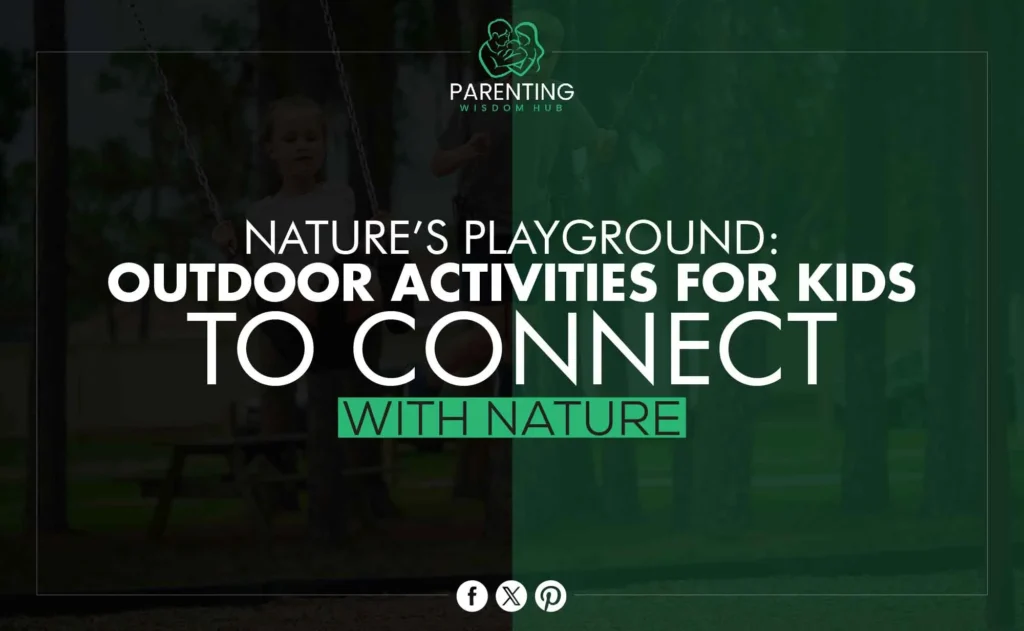Introduction
In the screen-dominated digital era, reconnecting with nature is more important than ever, particularly for youngsters. Engaging children in nature fosters curiosity and a deep respect for the environment. This blog article will show you outdoor activities for kids that are excellent for families, nature lovers, and educators looking to instill a love of nature in kids. This inquiry will provide practical strategies and fun activities that make nature play rewarding for everyone. Read more about Technology activities for kids.
Importance of Outdoor Activities
Child development relies on outside activities. Nature stimulates children’s senses more than indoor activities do. The rustling of leaves and the sensation of dirt build sensory skills. Being outside promotes healthy, fitness-boosting physical activities. Running in open places or climbing trees nourishes body and mind with workouts and adventure.
Nature play boosts imagination and creativity. Without toys or devices, kids make up games and tales. Sticks become magic wands, rocks treasures. Play that promotes problem-solving and critical thinking is crucial for cognitive development. Risk-taking and perseverance as they overcome new natural hurdles are great lessons for kids.
Planning Your Nature Adventure
Preparation is key before outdoor outings. Choose a place with many natural characteristics. A park with trees, water, and fields offers varied learning opportunities. Considering geography and weather, make the place child-friendly.
Next, bring things you’ll need, like water, snacks, and a first-aid kit. It’s also essential to wear the right clothes; layers are great for when the weather changes. Remember to bring hats and sunscreen to protect yourself from the sun. Getting kids to help pack can be a learning experience in and of itself, teaching them to be responsible and ready.
Lastly, make some simple rules to keep everyone safe without distracting from the fun. Tell kids how important it is to stay close, not eat things they don’t know about, and be kind to animals. This method helps kids learn limits while still letting them enjoy the freedom of playing outside.
Explore the Local Flora and Fauna
Exploring local flora and animals is a simple yet enjoyable outdoor activity. Start with a species-identification nature stroll. Give youngsters an essential handbook or smartphone app to learn about local flora and animals. This practice improves observation and promotes respect for life.
Encourage kids to keep nature journals. Drawing or writing about their observations reinforces learning and makes a great memory book. To expand their ecological understanding, explore woods, marshes, or meadows.
Kids will enjoy treasure hunts, where they have to find certain rocks, bugs, or leaves. In addition to making learning more fun, this gives people a feeling of achievement. Scavenger hunts can be changed to fit different age groups and educational goals because they can be made harder or more accessible.
Weather Permitting Adventures
Take advantage of the weather to teach kids about how different nature is. On rainy days, you can look around in puddles and watch how water changes the world around you. Giving kids rain boots and jackets will turn bad weather into a chance to learn and have fun while splashing around.
Shadow play and solar projects are great things to do on sunny days. Show kids how shadows change depending on where the sun is, or let them use magnifying glasses to safely look at how sunlight works. These tasks give kids a chance to learn about how the sun affects nature and allow them to do scientific research.
Windy days are good for kite-flying or building natural windchimes. These activities help kids learn about wind patterns and environmental impacts. Encourage children to observe tree swaying or wind noises to appreciate nature.
Creative Art with Natural Elements
Encourage kids to be creative by having them use natural items for art projects. Gather rocks, leaves, and sticks to make nature figures or paintings. These kinds of tasks help kids improve their fine motor skills and artistic expression while also bringing attention to the beauty in daily nature.
Making projects from nature, like leaf prints or drawing on rocks, is a great way to teach about the environment while also enjoying art. You can make these projects with very few materials, and they give you a creative way to show yourself. They also make great gifts or keepsakes for kids to remind them of their fun outside times.
You might want to create a nature art show where kids can show off their work. This would make them feel better about themselves and get other people involved in the community, which would let more people enjoy and interact artistically with the surroundings.
Building Forts and Shelters
Building houses out of natural materials is fun, teaching you how to work with others and solve problems. Help kids gather sticks, leaves, and other things they can use to make a small shelter or fort. This hands-on game helps kids learn about space and how to plan.
Teach the kids about how animals build their homes and get them to think of ways that humans can do the same. This can get them talking about areas and how animals have changed to survive in different environments, which can help them learn more about how ecosystems work.
Dismantle constructions after play to reduce environmental effects. Children learn conservation and responsibility by leaving nature as they found it.
Water-Based Activities
Dismantle constructions after play to reduce environmental effects. Children learn conservation and responsibility by leaving nature as they found it.
When you go to the beach, you can build sandcastles, look around in tide pools, or collect rocks. With these activities, you can learn more about sea life and coastal areas while being outside.
If you don’t live near a body of water, you can still have fun in the water by using sprinklers or plastic pools in your backyard. Adding toys and tools like nets and cups can make learning more fun and help kids understand how water moves and its traits.
Nighttime Nature Exploration
Do outdoor tasks with your kids at night to help them learn more about the world at night. Plan a night for the whole family to look at the stars and use apps to help you find constellations and planets. Taking part in this game makes you love science and asking scientific questions.
Night walks are a great way to learn about animals that come out at night and how they behave. Give children flashlights and show them how the world changes at night. Listening to sounds like owls or bugs at night can be very exciting.
Camping in your backyard or at a nearby spot lets you experience nature at night. Teach kids how to stay safe around campfires, tell stories, and stay alive; the experience will be educational and memorable.
Educator’s Guide to Outdoor Learning
Teachers can improve students’ learning by including outdoor activities in their lessons. Nature-based education helps students think critically and solve problems by using what they’ve learned in the classroom in real life.
Plan lessons that involve nature, like using yard projects to learn about plants or local areas to learn about geography. These methods make learning real and useful, which gets students more involved.
Work with other teachers to plan outdoor learning days for the community and share tools and ideas. These kinds of programs encourage students and teachers to care about the world.
Building a Sense of Community Through Nature
Outdoor events are a great way for people to get to know each other better. Set up nature clubs for families or events like park cleanup days. These events encourage people to get to know each other and take care of the world as a group.
Families should be encouraged to share their thoughts and experiences with community boards or social media. As a result, nature lovers can support one another and find inspiration and motivation in one another.
Volunteering or participating in neighborhood protection projects can help you get to know people who care about the same things you do. These projects not only help the earth, but they also bring people together and make friends for life.
Safety Tips for Outdoor Adventures
Safety is very important when experiencing wildlife. Always let someone know what you’re going to do and when you expect to be back. Use maps or GPS devices to keep from getting lost, especially in unfamiliar places.
Teach kids to stay safe around wildlife by telling them to respect animals and avoid them. You must know what to do if you run into someone for safety reasons and to protect the environment.
Lastly, everyone should know how to give simple first aid and bring a kit on trips. Being ready for small accidents can prevent them from becoming big problems and ensure that everyone has a good time.
Conclusion
Outdoor activities improve family life. Nature play helps kids develop creativity and responsibility. Families, educators, and nature lovers can connect with nature by following the above activities and advice. Plan a nature walk or community event to improve lives and motivate future generations to safeguard the earth. Join outdoor education groups or visit nature centers for additional ideas and resources.


